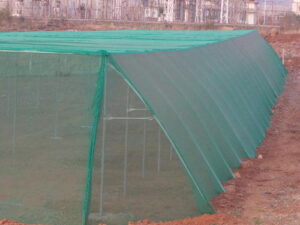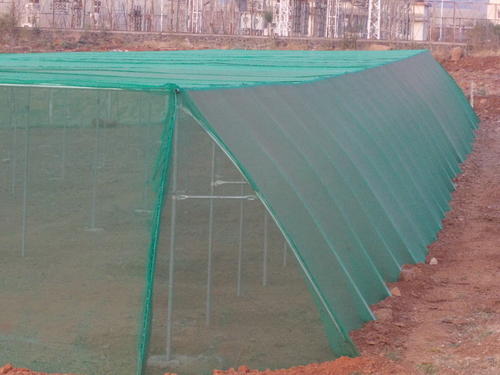Flat type Net house For Poly House is also used as green house & nethouse.
Pests and insects cause immense damage to the yield by feeding on or sucking the plant, depositing eggs on the crop and spreading disease.
How do the Nets Work?
- Flat Type Net House : Light Weight frames with poles and cables that support the net.
- Greenhouses: Air Vents are covered with nets, or all the greenhouse walls are made of nets.
- Walk-in Tunnels: completely covered with net, or covered with net and PE sheets.
- OptiNet is a sophisticated new-generation anti-insect net that integrates physical and optical protection.
Anti Insect Nets:
- 17-mesh net: For protection against fruit files (Mediterranean fruit fly and Fig fruit fly) in orchards and vineyards,Grape moth and Pomegranate Deudorix livia.
- 25-mesh net: For protection against mediterranean fruit fly in peppers.
- 40-mest net: For partial blocking of white flies where climatic conditions do not allow the use of 50 mesh nets.
polyester netting which has insecticide bound to the external surface of the netting fibre using a resin;
polyethylene which has insecticide incorporated into the fibre and polypropylene which has insecticide incorporated into the fibre.
These nets come with a guarantee of 5 Years against UV degradation.

Introduction to Flat Type Net Houses
Flat type net houses are an innovative solution for protected cultivation in agriculture. These structures offer a cost-effective and efficient way to create a controlled environment for plant growth, minimizing the impact of pests, diseases, and extreme weather conditions. With their lightweight and easily assembled design, flat net houses have gained popularity among farmers and gardeners around the world.
Key Components of Flat Type Net Houses
-
Frame: The frame of a flat type net house is typically constructed using metal or PVC pipes. These materials provide the necessary support and stability for the structure. The frame can be easily customized to fit the desired dimensions and shape of the net house.
-
Covering: The covering of a flat type net house is made of a fine mesh netting material. This netting serves as a protective barrier, shielding the plants from harmful insects, pests, and excessive sunlight. The netting allows for adequate air circulation and light penetration, ensuring optimal growing conditions.
Advantages of Flat Type Net Houses
-
Cost-effectiveness: Flat net houses are a more affordable alternative to traditional greenhouses. The simplicity of their design and the use of cost-effective materials make them an attractive option for small-scale farmers and growers with limited budgets.
-
Flexibility and Portability: Flat type net houses are easily assembled and disassembled, providing flexibility in terms of location and seasonal use. They can be relocated or expanded as needed, allowing for efficient land utilization and crop rotation.
-
Protection from Pests and Diseases: The fine mesh netting of flat net houses acts as a physical barrier, preventing the entry of pests, insects, and birds that can damage crops. This protection reduces the reliance on chemical pesticides, making flat net houses an environmentally friendly choice.
-
Climate Control: Flat type net houses offer better control over temperature, humidity, and ventilation compared to open-field cultivation. The netting material allows for the exchange of air while minimizing temperature fluctuations, creating a more stable microclimate for plant growth.
Suitable Crops for Flat Type Net Houses
A wide range of crops can be successfully cultivated in flat type net houses. Popular choices include leafy greens, herbs, strawberries, cucumbers, and various flowers. The controlled environment provided by flat net houses enables year-round cultivation and extends the growing season, allowing farmers to optimize their production and meet market demands.
Flat type net houses have emerged as an effective solution for protected cultivation, offering numerous advantages for farmers and gardeners. Their affordable cost, flexibility, and ability to provide protection against pests and diseases make them an appealing option for small-scale and medium-scale growers. With proper management and suitable crop selection, flat type net houses can contribute to increased productivity and improved quality in agriculture.
Design and Construction of Flat Type Net Houses:
Flat type net houses are designed to provide a controlled environment for plant growth while offering protection from pests, diseases, and excessive sunlight. The design and construction of these structures involve selecting appropriate materials and structural configurations. Let’s delve into the different aspects of designing and constructing flat type net houses:
Structural Designs:
-
Arched Design: One common design for flat type net houses is the arched shape. This design provides structural strength and allows for better snow or rain runoff. The curved shape also facilitates better air circulation inside the net house.
-
Gable Design: Another popular design is the gable shape, which features a peaked roof. The gable design provides better height and allows for easy installation of ventilation systems. It also provides more space for hanging equipment and allows for better light transmission.
-
Quonset Design: The quonset design involves a semi-circular or rounded roof supported by vertical side walls. This design is simple, cost-effective, and easy to assemble. It offers good strength and stability while optimizing space utilization.
Materials:
-
Metal Pipes: Metal pipes, such as galvanized steel or aluminum, are commonly used for the frame of flat type net houses. These pipes are sturdy, durable, and resistant to corrosion. They provide the necessary support for the netting and can withstand varying weather conditions.
-
PVC Pipes: PVC (polyvinyl chloride) pipes are lightweight, affordable, and easy to work with. They are a popular choice for smaller and temporary flat net house structures. PVC pipes are resistant to corrosion but may not be as durable as metal pipes.
-
Netting Materials: The netting material used for covering the flat net house should be fine enough to prevent the entry of pests and insects while allowing sufficient airflow and light penetration. Common netting materials include polyethylene (PE) netting, polypropylene (PP) netting, and nylon netting.
-
Anchoring Materials: Anchoring materials such as ground stakes, ropes, or concrete footings are used to secure the flat net house to the ground. These ensure stability and prevent the structure from being damaged by strong winds or other external forces.
Considerations:
-
Size and Layout: The size of the flat net house should be determined based on the intended crop and the available space. Considerations should also be made for pathways, access points, and potential expansion.
-
Climate and Environmental Factors: The design and construction of the flat type net house should take into account the specific climatic conditions of the area, including wind speed, snow load, and rainfall. This will ensure that the structure is resilient and can withstand environmental challenges.
-
Ventilation and Cooling: Adequate ventilation is crucial for maintaining optimal growing conditions inside the net house. Consider incorporating features such as roll-up sidewalls, ridge vents, or exhaust fans to facilitate air movement and temperature control.
-
Accessories and Additional Features: Depending on the specific requirements, additional features such as doors, irrigation systems, shading materials, and insect screens can be incorporated into the design.
The design and construction of flat type net houses involve selecting suitable structural designs and materials that provide strength, durability, and functionality. Considerations such as size, climate, ventilation, and additional features play a vital role in creating an effective and efficient environment for crop cultivation. By carefully planning and implementing the design and construction process, farmers and growers can optimize their crop production and maximize the benefits of flat type net houses.
Economics and Profitability of Flat Type Net Houses:
Flat type net houses offer several economic advantages and can be a profitable investment for farmers and growers engaged in protected cultivation. Analyzing the cost-benefit ratio, potential returns, and market opportunities associated with flat net house cultivation is essential for making informed decisions. Let’s explore the economic aspects of flat type net houses:
Initial Investment:
-
Construction Costs: The construction costs of a flat type net house typically include materials, labor, site preparation, and infrastructure. The specific costs will vary depending on the size, design, and materials used. However, flat net houses are generally more cost-effective compared to traditional greenhouse structures.
-
Equipment and Technology: Additional costs may be incurred for equipment such as irrigation systems, climate control devices, and automation technology. These investments can optimize crop management and increase productivity.
Operational Costs:
-
Energy and Utilities: Flat type net houses require energy for heating, cooling, and ventilation systems. The operational costs associated with maintaining a suitable climate within the net house should be considered.
-
Labor: Labor costs will depend on the scale of operations, crop management requirements, and level of automation. Skilled labor may be required for tasks such as crop monitoring, irrigation, pest control, and harvesting.
-
Maintenance and Repairs: Regular maintenance, repairs, and replacement of worn-out components should be factored into the operational costs. This includes netting replacement, structural repairs, and equipment maintenance.
Crop Selection and Market Opportunities:
-
Crop Suitability: Flat type net houses can be used for growing a wide range of crops, including leafy greens, herbs, vegetables, fruits, and flowers. The choice of crops should be based on market demand, profitability, and suitability for the controlled environment provided by the net house.
-
Market Demand: Assessing the local and regional market demand for specific crops is crucial for determining the potential returns on investment. Consider factors such as consumer preferences, market trends, and pricing dynamics.
-
Seasonal Production and Market Gaps: Flat type net houses allow for extended growing seasons and year-round production. By strategically timing crop production, farmers can take advantage of seasonal market gaps and potentially command higher prices.
Potential Returns and Profitability:
-
Yield and Productivity: Flat net houses can enhance crop productivity and yield due to the controlled environment, reduced pest pressure, and optimized growing conditions. Higher yields can translate into increased profitability.
-
Premium Pricing: The market demand for locally grown, pesticide-free, and high-quality produce often commands premium prices. Flat net houses enable growers to meet these demands and potentially earn higher profits.
-
Cost Reductions: The reduced reliance on chemical pesticides and optimized resource use can lead to cost savings in crop inputs. Efficient water management and fertilization practices can also contribute to cost reductions.
-
Return on Investment (ROI): Calculating the ROI of a flat type net house involves analyzing the initial investment, operational costs, and potential returns over a specific period. ROI can vary based on factors such as crop selection, market conditions, and management practices.
Evaluating the economics and profitability of flat type net houses requires careful analysis of construction costs, operational expenses, crop selection, and market opportunities. Despite the initial investment, flat net houses offer advantages such as improved productivity, extended growing seasons, and potential market premiums. Conducting a thorough cost-benefit analysis, understanding market dynamics, and implementing efficient management practices can contribute to the profitability and success of flat type net house cultivation.





